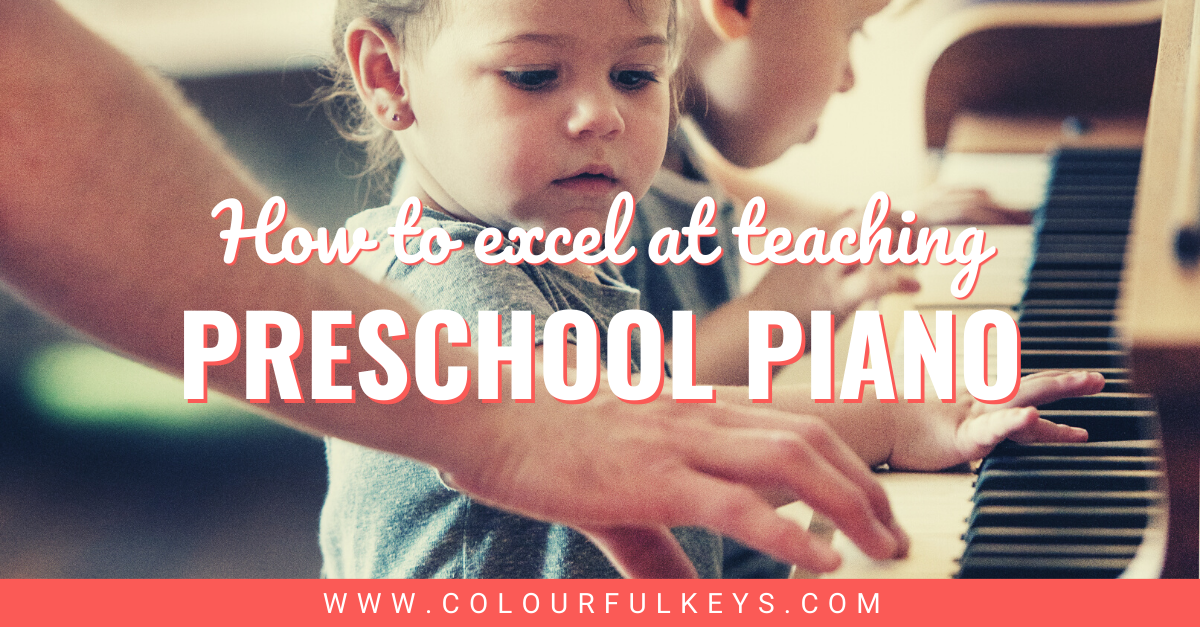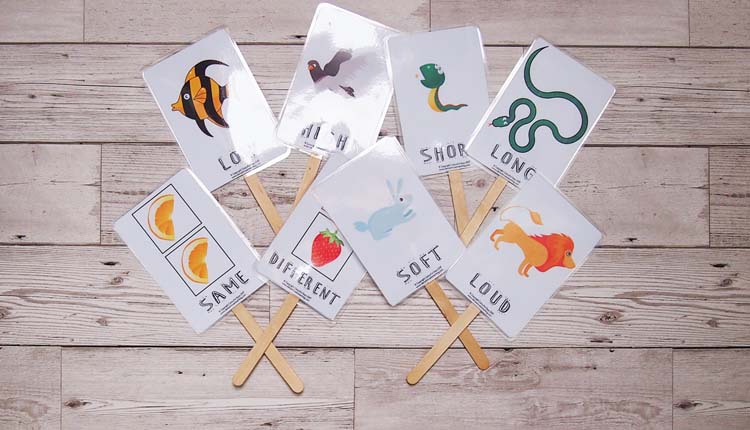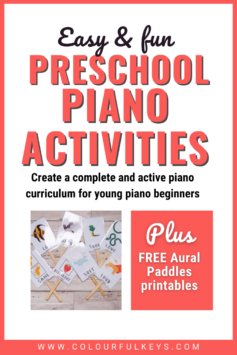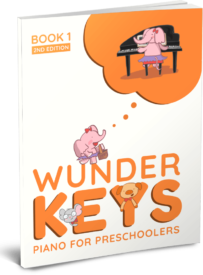
This blog post about finding your perfect preschool piano curriculum was written by Amanda Shaw-Yagoub. Amanda lives with her family and a menagerie of small pets on a little island near Montreal, Quebec in Canada. She’s a writer, translator, musician and homegrown teacher who loves to share her passions with others. When she’s not out exploring her island or taking care of the many beasts who depend upon her, she’s teaching piano, English literature or ESL. The most commonly-heard phrase in her studio (and the one which elicits the most giggles and groans from her students) is, “Play it again!”
So, you’ve decided to teach preschoolers. Welcome to the other side! Preschoolers can be one of the most fun groups to teach – but they can also be one of the most challenging.

After years of teaching school-aged kids, I decided it would be fun to expose younger kids to the building blocks of music, preparing them for future music lessons.
Not only would they benefit from early exposure to things like rhythm and pitch, but it would also be a natural way to funnel students into my piano studio.
A win-win!
But after that first lesson trying to teaching solfa to ten little blank faces, I knew that my preschool piano curriculum would have to be radically different from the tried-and-trues I use with older kids.
You don’t have to make the same mistakes that I did (although you might still find yourself reminding little George to wash his hands after picking his nose).
Set yourself up for success from the very start by finding or building the perfect preschool curriculum for your own piano studio.
Start With a Preschool Piano Method Book
There are so many method books out there. But how do you choose the right ones for your preschoolers?
You really have just 2 options:
- Try a method that is designed specifically for preschoolers
- Adapt a favourite series that you already use with your older students
Whatever you choose, do not stress. A method book, especially for preschoolers, should be a rough guide rather than the be-all-and-end-all.
In fact, you may find that dipping in and out of a preschool method book is preferable and much easier.
Want Nicola’s recommendations for many popular method books? Members of Vibrant Music Teaching can access the ever-growing collection of reviews anytime.
Preschool Method Books
There are several great options when it comes to preschool method books, but WunderKeys and Piano Safari Friends deserve special mention in my opinion.
WunderKeys Ages 3 – 5
My personal favourite preschool piano method book is WunderKeys by Andrea and Trever Dow.
Pros
- Attractive and fun books are full of colour, stories and games – perfect for preschoolers
- Each week is a self-contained lesson, combining basic musical elements alongside things that children are already learning in school
- Lessons are highly repetitive and routine
- The method is varied and covers a wide range of material, including singing, reading and rhythm work
- Easy for parents to use for home practice
- It’s the only method on the mass market for 3-year-olds!
Cons
- It can be very cluttered, which can be very distracting and overwhelming for some children
- You’ll be buying a new book every 10 weeks, as there are 10 lessons
- It’s slow and progressive which could get boring, but will hit the sweet spot for most 3-year-olds
Piano Safari Friends Ages 4 – 6
Piano Safari Friends is the prequel to Piano Safari Level 1 by Julie Knerr Hague and Katherine Fisher.
Pros
- It’s not cluttered with colour, games and activities, focussing more on the music itself
- If you’re a fan of Piano Safari, this book will prepare your student for moving into Piano Safari Level 1
- Comes with an excellent teacher guide and other free resources so you can learn how to use the method
Cons
- Isn’t as easy for parents to follow at home without guidance from the teacher
- “Follow the Leader” pieces require a teacher accompaniment or free “leader” videos from YouTube
- Higher upfront cost
VMT members, remember to use your Piano Safari discount code to get 10% off your purchase.
Adapting Beginner Method Books
In truth, most beginner method books aimed at younger children will work for preschoolers – but will need some adaptation.
When supplementing beginner method books, remember the following:
- You don’t have to teach absolutely everything in the book
- Take time away from the piano – preschoolers learn best through play, exploration and movement
Craft Your Preschool Piano Curriculum
Now that you have your method book, you’re ready to create your perfect preschool piano curriculum.
Start by deciding what you want your preschoolers to know, and by when. Here’s an example of the first-month goals for a 4-year-old. For a longer view, determine your first-year goals. Then slot in everything in between.
Once you have a general idea of what you want your students to learn, and when, you can start mapping it to your method book.
Go through the method book one unit at a time. Decide what you want your students to learn in that unit, and brainstorm what activities you can add in to meet your own goals.
Why start from scratch if you don’t have to? Members of Vibrant Music Teaching can download a ready-made, Nicola-approved preschool curriculum called Tiny Finger Takeoff. There are 40 lessons already laid out, ready for you to add in the pieces from your choice of method book. There are even training videos from Nicola for every single one of the 40 lessons!
Creating your own preschool piano curriculum can be overwhelming if you’re starting from scratch, so remember to start at a high level (with benchmarks along the way) before drilling down to the actual activities.
Preschool Curriculum Tips & Tricks
When crafting your preschool piano curriculum, there are a few key things to keep in mind.
Teaching Musical Concepts
At this age, students need to be actively taught things that teachers can take for granted.
Preschoolers don’t necessarily even know what it means for a sound to be qualified as high or low. Similarly, I find that they also struggle to know the difference between long and short sounds – especially on the piano.
I like to start out my first few classes with the same exercise: I play a high note while saying, “This is a high sound!” then I play a low note while saying, “This is a low sound!” I alternate between the two in a sing-songy voice, increasing the speed slightly as I go, and soon those preschool piano students are singing right along with me.
They need to be taught to feel in their bodies what those two words mean before they can even begin.
Aural Training Paddles are a fun way to turn aural skills work into a game. Enter your info below and Nicola will send them right to your inbox.

Subscribe to the newsletter and get the Aural Training Paddles.
Enter your details to subscribe to the newsletter for piano teachers with information, tips and offers.
I hate spam as much as you do! I will only send you emails related directly to piano teaching and you can unsubscribe at any time.
Already a member of VMT? You can snag the paddles from the VMT library instantly. Not a member? Find out what you’re missing at vibrantmusicteaching.com.
Lean Into Your Students’ Love of Repetition
Likewise, don’t be afraid of repetition. Preschool students need to circle back to concepts many times before they internalise them. The good thing is, they like repetition! They know what to expect and enjoy the feeling of mastering something.
Turn Everything Into a Game
One of the most important things to do in your preschool piano curriculum is “gamify” everything. Simply put, all ages learn best through play. When something is fun, interesting and absorbing, students want to try and try again.
The Vibrant Music Teaching Printable Library is the source for piano games of all levels. But at this age, games don’t have to be complicated. You can turn almost any concept into a game.
Here are some of my students’ favourite games to play:
- Keyboard Builder
- Perfect for building keyboard geography
- Start by getting your preschoolers to recognise the groups of 2 and 3 black keys
- Once they can do this, try learning the groups of CDE and FGAB
- Measure Match
- Lay out one simple bar (measure) of music with 4 pitches in the treble clef on a big grand staff. (I use a big velcro grand staff, but you could use a pencil and paper.)
- Have your preschool students replicate the bar (measure) on their own velcro board placing notes on the same lines and spaces, in the same order. I like to give them three chances to get it right.
- Finally, show them how to play it on the piano!
- Musical Alphabet
- By age 3, most preschoolers are pretty familiar with the alphabet. Those who know it already will find it funny that the musical alphabet ends at G; those who don’t know their alphabet will benefit from learning the first seven letters.
- Get a set of about 30 music alphabet cards. (VMT members could use cards from the Betty Blanks game for this.)
- Tell your student to pick two cards. Their challenge is to fill in the letters in between, in order, without making any mistakes.
- If they can do it three times in a row correctly, they win the game!
Preschoolers love the familiarity of repetition so lean into this by repeating games over and over each week, especially if they need extra reinforcement.
Get up and get moving!
Have you ever tried to make a four-year-old sit on a piano bench for 30 minutes straight? I don’t recommend it 😊
Studies show that young children learn best when they move their bodies, and a piano lesson is no exception.
The perfect preschool piano curriculum will account for this by providing ample opportunities for your preschooler to get off the bench.

Try aiming for 5 minutes on, and 5 minutes off. However, I’d never hurry a concentrated child off the bench and similarly, I might only have an especially active child on the bench at the very beginning and end of her lesson.
Off-the-Bench Ideas
Need some ideas for things to do off-the-bench? Try these:
- Intervals
- Get your student walking intervals. For example, tell your preschool students to take one step if you play two notes close together (a 2nd) or two steps if you skip a note (a 3rd).
- Chords
- Practise hearing one or two notes at the same time. For example, give your preschool student two soft objects, such as stuffed animals. If they hear one note, ask them to throw one object into a basket, or both objects into the basket if you play two notes together.
- Pitch
- Move directionally to sounds. For example, have your preschoolers stretch up high when they hear you play a high sound and crouch down low when they hear a low sound. Besides helping them to internalise the vocabulary related to pitch, it’s just plain fun!
Finish With a Wind-Down Activity
Structure and routine are key with very young children.
Preschoolers are full of energy, and because your lessons are going to be lots of fun, they may get even more excited than usual. It can be nice for both teacher and students (and parents!) to wind down the lesson with a short listening activity.
My go-to listening activity is so simple that it will be easy to incorporate into any preschool piano curriculum; and yet, it’s so loved by my preschool students that they ask for it time and again.
I sit with them on the ground for this one. We close our eyes and listen to about one minute of a composition. I’ve used everything from Grieg’s “Morning Mood” to Debussy’s “Clair de Lune”. Then we open our eyes and share what the music made us think of. It’s calming and therapeutic and will have your preschool students leaving their piano lessons feeling happy.

What would the non-negotiables be in your own preschool piano curriculum?
How do you think your perfect preschool piano curriculum would differ from your current program for older students? Share your thoughts in the comments below.
Because preschoolers are a whole other creature, Nicola has an entire page devoted to teaching preschoolers. Check it out for more awesomeness!


This is a well written post. These ideas WORK! Just as an FYI. I include a Black & White Panda Hans puppet who wants to hear ‘white or ‘black key’ sounds (improv) as well as Count Teddy stuffy who teaches note values with a song.